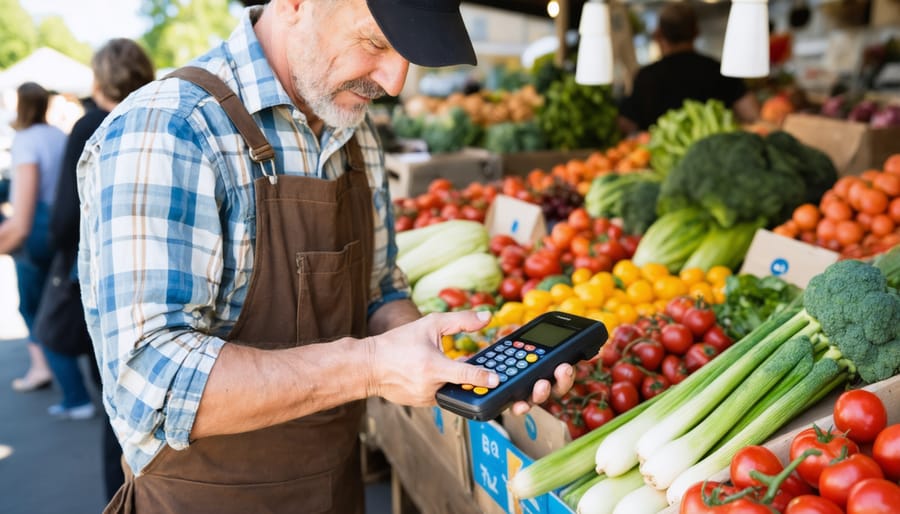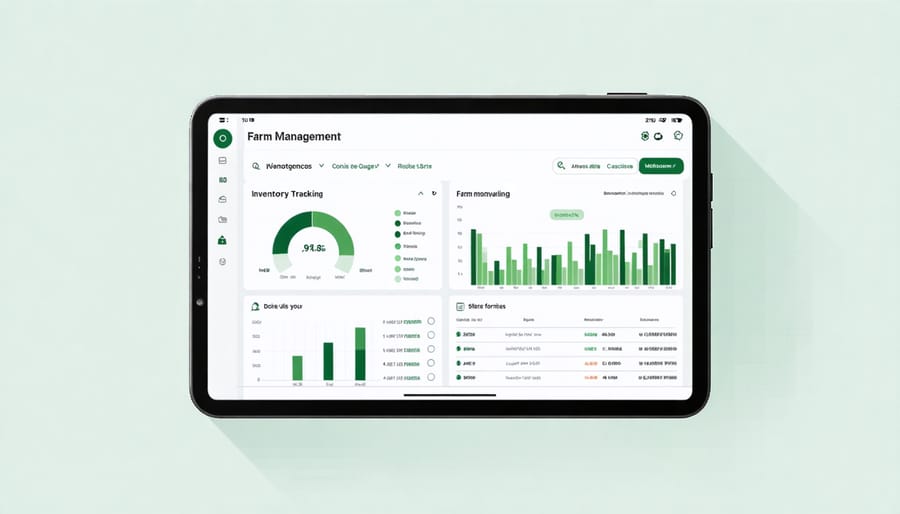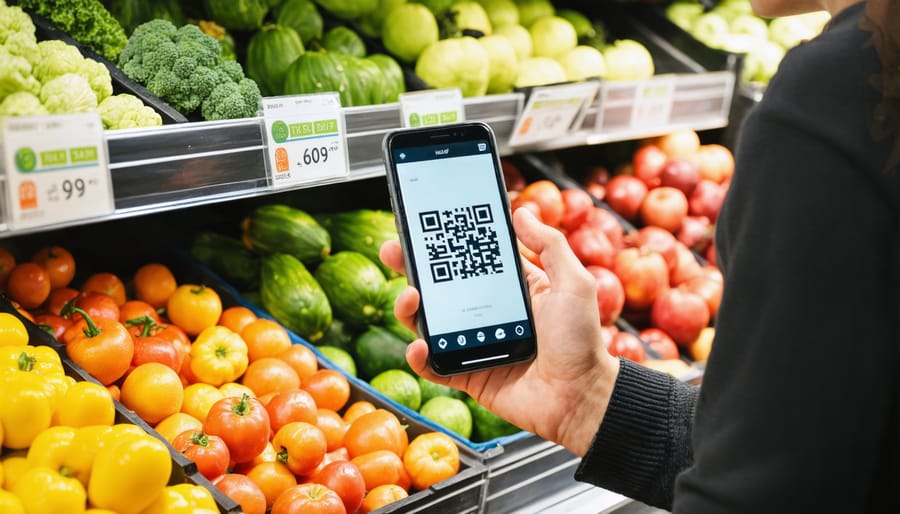Modern agriculture stands at the precipice of a technological revolution, fundamentally reshaping how we grow, harvest, and transform the farm-to-table experience. From AI-powered drones monitoring crop health to precision farming systems that optimize water usage down to the last drop, technology is empowering farmers to produce more food while using fewer resources. Smart sensors now blanket fields, collecting real-time data about soil conditions, weather patterns, and plant health, while autonomous tractors guided by GPS work tirelessly to plant, maintain, and harvest crops with unprecedented accuracy. This fusion of traditional farming wisdom with cutting-edge innovation isn’t just improving yields – it’s creating a more sustainable and resilient agricultural system capable of feeding our growing global population while protecting the planet’s precious resources. As we embrace these advances, we’re witnessing the dawn of Agriculture 4.0, where data-driven decisions and automated solutions work hand-in-hand with generations of farming knowledge.
Digital Payment Solutions Transform Market Days
Mobile Payment Apps and Digital Wallets
Gone are the days when farmers markets were cash-only operations. Today’s tech-savvy farmers are embracing mobile payment apps and digital wallets to make transactions smoother and more convenient for everyone. Popular platforms like Square, Venmo, and PayPal have become essential tools at market stalls, allowing customers to pay with just a tap of their phones.
These digital payment solutions offer multiple benefits for farmers. They reduce the need to handle cash, minimize accounting errors, and provide detailed sales reports that help track inventory and business growth. Many apps also generate digital receipts, making it easier to maintain accurate records for tax purposes.
For customers, these payment options mean no more rushing to ATMs or missing out on fresh produce because they forgot to bring cash. Digital wallets also enable convenient features like splitting payments for group purchases or setting up recurring payments for CSA memberships.
Some farmers report seeing up to a 25% increase in sales after implementing digital payment options, as customers tend to spend more when using contactless payments. Plus, these systems help create a more professional image while maintaining the friendly, personal atmosphere that makes farmers markets special.

Online Pre-ordering Systems
Modern farmers markets are embracing online pre-ordering systems to create a more convenient shopping experience for both customers and vendors. These user-friendly platforms allow shoppers to browse available produce, reserve items in advance, and schedule pickup times, eliminating the disappointment of arriving at the market only to find favorite items sold out.
Local farmers benefit from this technology by better predicting demand and reducing food waste. They can harvest exactly what’s needed and plan their market inventory more efficiently. Many successful vendors report that pre-orders now account for up to 40% of their weekly sales, providing a reliable income stream even during unpredictable weather conditions.
These systems typically feature real-time inventory updates, secure payment processing, and automated confirmation emails. Some advanced platforms even integrate with farm management software to track crop availability and send harvest reminders to farmers. For customers, the experience feels similar to familiar online shopping but maintains the personal connection with local growers through customized messages and pickup interactions.
The move toward digital pre-ordering has proven especially valuable during peak seasons when markets are bustling with activity. It helps maintain social distancing when necessary and ensures everyone can access fresh, local produce efficiently.
Farm Management Apps Hit the Market Stalls

Inventory Management Solutions
Modern farming has embraced digital solutions that make market stall management more efficient than ever before. Cloud-based inventory systems now allow farmers to track their produce from seed to sale, ensuring nothing goes to waste. These smart tools help predict harvest times, manage stock levels, and plan market days with precision.
Popular apps like Farmhand and MarketWise let growers scan QR codes on harvest bins to instantly update their inventory. This real-time tracking helps farmers know exactly what’s available, reducing the risk of overselling or running out of popular items during market hours. Some systems even integrate with weather forecasts to help plan harvesting schedules and market day preparations.
Digital inventory management also helps farmers maintain detailed records of crop varieties, growing conditions, and sales patterns. This data becomes invaluable for planning future growing seasons and understanding customer preferences. Many systems can generate reports showing which products sell best at different times of the year, helping farmers optimize their planting schedules and market day offerings.
For small-scale farmers, these tools have become game-changers, allowing them to compete more effectively while maintaining the personal touch that makes farmers markets special.
Customer Relationship Management Tools
Modern farming isn’t just about growing crops – it’s about growing relationships with customers too. Today’s farmers are using sophisticated CRM (Customer Relationship Management) tools to stay connected with their loyal customers and build stronger communities around their farms.
Digital platforms like Farmigo and Local Food Marketplace help farmers track customer preferences, manage CSA subscriptions, and send automated updates about harvest schedules and product availability. These systems can remember which customers prefer specific varieties of tomatoes or who’s interested in bulk purchases for canning season.
Many farms now use mobile apps to run loyalty programs, rewarding regular customers with points or special discounts. These apps also collect valuable feedback, helping farmers adjust their growing plans based on customer demand. Some systems even integrate with social media, allowing farmers to share real-time updates about fresh picks or upcoming market days.
Email marketing tools designed specifically for farms help maintain personal connections through newsletters featuring recipe ideas, farm updates, and upcoming events. The best part? These systems are becoming more user-friendly, allowing even tech-hesitant farmers to manage customer relationships effectively while spending more time in the fields where they’re needed most.
QR Codes Tell Your Food’s Story

Track Your Produce Journey
Ever wondered where your tomatoes really came from? Thanks to innovative tracking technology, you can now trace your produce’s journey from seed to shelf. Many farms are implementing QR codes on their packaging that, when scanned with your smartphone, reveal the complete story of your fruits and vegetables.
Local farmer Sarah Chen from Green Valley Farm uses blockchain technology to track her organic produce. “Customers can see when their lettuce was planted, harvested, and delivered,” she explains. “They even get to know which field it grew in and what organic practices we used.”
Several user-friendly apps now connect consumers directly with their food’s origin story. For example, HarvestMark lets you input a code from your produce to view its full journey, including temperature logs during transportation and certification details. The Farmers Market Finder app helps locate markets near you that use produce tracking systems.
This transparency isn’t just about satisfying curiosity – it’s about food safety and supporting local farmers. When you know exactly where your food comes from, you can make more informed choices about your purchases and build stronger connections with the farmers who grow your food.
Digital Recipe Integration
QR codes are revolutionizing the way shoppers interact with fresh produce at farmers markets, creating a seamless bridge between farm-fresh ingredients and delicious home-cooked meals. With a simple smartphone scan, customers can instantly access curated recipe collections that feature the seasonal produce they’re buying.
These digital recipes go beyond basic cooking instructions. Shoppers receive detailed nutritional information, storage tips, and even video tutorials showing creative ways to prepare unfamiliar vegetables. For example, when scanning a QR code on a bundle of rainbow chard, customers might discover both traditional sautéing methods and innovative ways to incorporate it into smoothies or wraps.
Many farmers are adding personal touches to these digital resources by including their own family recipes and cooking tips passed down through generations. Some even feature short videos of themselves preparing dishes using their produce, adding a personal connection that bridges the gap between field and kitchen.
This technology helps reduce food waste by giving shoppers confidence to try new ingredients and ensuring they know how to properly store and prepare their purchases. It’s particularly helpful for seasonal items that might be unfamiliar to some customers.
Real-Time Market Updates Keep Shoppers Informed
Gone are the days when farmers market shoppers had to guess what produce would be available on market day. Modern communication technology has revolutionized how farmers connect with their customers, creating a more efficient and enjoyable shopping experience for everyone involved.
Many farmers now use mobile apps and messaging platforms to send real-time updates about their harvest schedules and available products. Customers can receive instant notifications when their favorite items are in stock or when new seasonal produce becomes available. Some markets have even developed their own apps that allow shoppers to browse vendor inventories before leaving home.
Social media platforms have become vital tools for market communication. Farmers regularly post photos of freshly harvested produce, share updates about weather impacts on crops, and announce special offerings or limited-time deals. These platforms also enable direct messaging between farmers and customers, fostering stronger relationships and building community trust.
Digital newsletters and text message services help farmers share weekly availability lists, recipe suggestions, and storage tips for seasonal produce. This information helps customers plan their shopping trips more effectively and make the most of their purchases.
Several markets now feature digital displays showing real-time inventory updates from various vendors. These screens help shoppers quickly locate specific items and discover new products they might have missed. Some systems even track popular items, helping farmers better predict demand and reduce food waste.
For tech-savvy farmers like Sarah Chen from Green Valley Farm, these tools have been transformative. “We used to lose customers who’d arrive after we’d sold out of popular items,” she says. “Now they know exactly what we’ll have before they visit, and they can even pre-order their favorites.”
The integration of technology in farmers markets represents an exciting evolution in how we connect with local food systems. Today’s farmers are embracing digital tools that make their operations more efficient while preserving the authentic, community-focused experience that makes markets special. From mobile payment systems that make transactions seamless to inventory management apps that reduce waste, these innovations are helping small-scale farmers thrive in the modern marketplace.
Looking ahead, we can expect even more exciting developments. Imagine scanning a QR code to instantly view a farm’s growing practices, or using augmented reality to see recipe suggestions as you shop. Smart sensors and data analytics will help farmers optimize their crops, while blockchain technology could provide unprecedented transparency in food sourcing.
These advancements aren’t just about convenience – they’re creating a more sustainable and resilient local food system. By embracing technology thoughtfully, farmers markets can continue to grow while staying true to their roots in community connection and sustainable agriculture. The future of farming combines the best of both worlds: time-honored growing practices enhanced by innovative solutions that benefit farmers and consumers alike.

